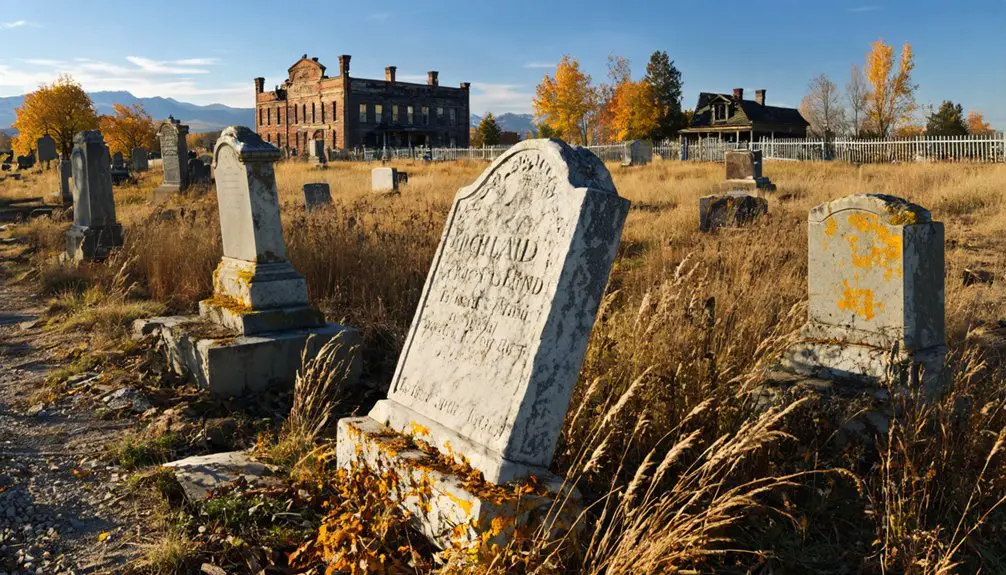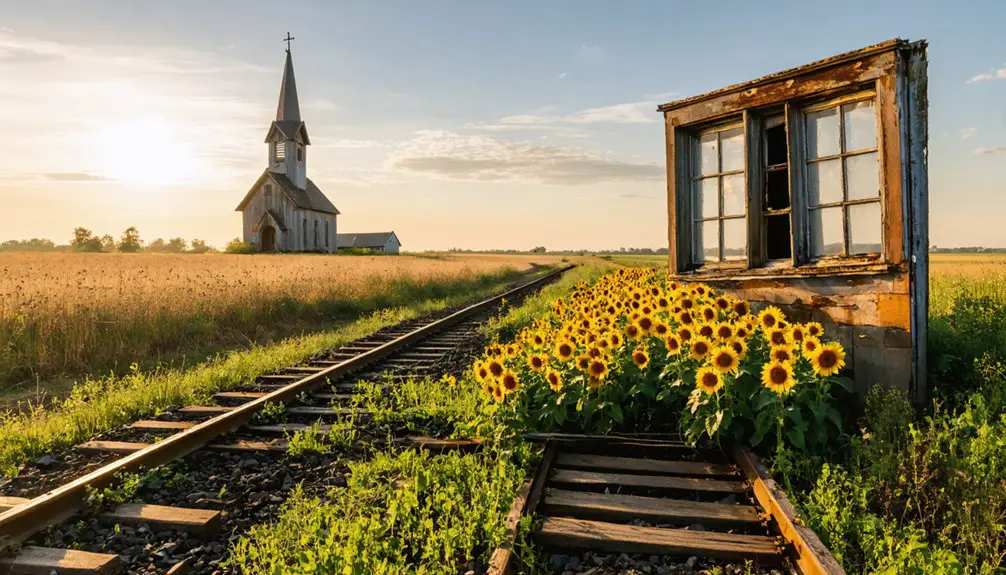You’ll find Baird’s historic remains 7 miles west of Coulee City, Washington, where James Baird established an essential post office and settlement in 1896. This elevated site between Moses Coulee and Grand Coulee supported farming families until 1934, when the post office closed. Today, Highland Cemetery stands as the most prominent remnant, featuring pioneer graves from the 1890s. The site’s rich past reveals deeper layers of Washington’s rural heritage.
Key Takeaways
- Baird was established in 1896 between Moses Coulee and Grand Coulee, serving as a farming community with a vital post office hub.
- James Baird founded the town’s post office and served as its first postmaster until operations ceased in 1934.
- The town’s decline began with the closure of its post office, eventually leading to its abandonment and ghost town status.
- Highland Cemetery remains a significant historical site, containing graves of early settlers dating back to the 1890s.
- The ghost town’s elevated location between two coulees offers protection for remaining historical remnants and cemetery grounds.
The Rise of a Rural Settlement
While many pioneer settlements emerged across Washington state in the late 1800s, Baird took root on elevated terrain between Moses Coulee and Grand Coulee, roughly 7 miles west of present-day Coulee City.
Perched between two dramatic coulees in Washington’s rugged landscape, Baird emerged as a testament to pioneer determination in the 1800s.
You’ll find its origins traced to 1896 when James Baird established the local post office, creating a crucial hub for the growing community’s communication and commerce. Similar to other place names, the town adopted the surname of its founding resident.
The settlement’s strategic location shaped its early community dynamics, with farming families settling the high ground for its agricultural advantages. Like many communities of its era, Baird relied heavily on the railroad networks for its economic viability.
You can see how the region’s geography influenced Baird’s development, as it positioned itself along key transportation routes connecting scattered homesteads.
Life in Early Baird
In early Baird, you’d find residents engaged in typical rural activities like farming and ranching while centering their community life around the local post office established in 1896.
Much like at Harts Pass, residents would gather at the local general store for essential supplies and community connection.
Your daily errands would’ve included collecting mail and supplies at this essential hub, which served as both a communication lifeline and social gathering spot for the small settlement positioned between Moses Coulee and Grand Coulee.
You’d have faced the common frontier challenges of limited infrastructure and isolation, though the town’s strategic location on high ground provided protection from natural hazards like flooding.
Daily Rural Life Activities
Life in early Baird centered around agricultural practices, with settlers taking advantage of the high ground for dry farming techniques. You’d find yourself tending to cattle and horses while managing crops suited to the arid conditions.
Water scarcity meant daily trips to haul water for both household needs and farming operations. Your daily routine would include working the land, maintaining buildings with local timber, and preserving food through canning and drying for winter months.
Community gatherings at the general store provided essential social connections, while cooperative efforts helped complete labor-intensive tasks like harvesting and barn raising. You’d rely on horse-drawn wagons for transportation along dirt roads to reach Coulee City for trading, though seasonal weather often determined when you could make these necessary trips.
Postal Service Operations
Three significant decades of postal operations began in 1896 when the Baird post office opened its doors, serving as a vital communication hub between Moses Coulee and Grand Coulee.
You’d find James Baird, the town’s namesake postmaster, managing essential duties like sorting mail and maintaining postal routes that connected to larger settlements like Coulee City.
The post office wasn’t just a mail station – it became the heart of the community where you could gather news and stay connected to the outside world.
Just like Evan Evans who worked as a mail carrier between Mount Idaho and Pierce City, dedicated postal workers braved the elements to ensure mail delivery.
Whether by horse, wagon, or early motor vehicles, mail delivery persisted through challenging terrain and weather conditions until 1934.
The post office’s closure that year marked a turning point, reflecting the town’s broader decline as Baird evolved into a ghost town, similar to how Almota’s post office closed in 1961 before the town was submerged.
Early Settlement Challenges
Settling in Baird meant facing intimidating environmental challenges that shaped daily existence. You’d find yourself perched between Moses Coulee and Grand Coulee, battling harsh weather extremes and dry conditions that tested your farming abilities. Much like the towns of Govan and Sherman, life revolved around the crucial railroad lines that connected these remote settlements.
With limited access routes and roughly 7 miles of rugged terrain separating you from Coulee City, getting supplies wasn’t easy. Much like the early Kansas colony settlers who attempted to establish themselves in Whatcom, many families struggled to gain a foothold in the challenging landscape.
Settler hardships included primitive living conditions, with basic structures built from local wood and stone. You’d work long hours doing manual labor, dealing with unreliable water sources and basic sanitation.
Yet community resilience emerged through necessity – you’d band together with neighbors to survive the isolation, sharing resources and labor. The remote location demanded self-sufficiency, whether you were ranching, farming, or pursuing small mining ventures.
James Baird’s Legacy
Pioneer James Baird’s enduring legacy spans from his humble beginnings as Baird, Washington’s first postmaster in 1896 to his remarkable achievements in American architecture.
You’ll find his early influence in the town that bears his name, strategically situated between Moses Coulee and Grand Coulee in Douglas County, where his homestead housed the post office until 1934. Like the stave factory in Cummings that met its demise in an 1891 explosion, his town gradually faded into history.
Baird’s contributions to America’s architectural heritage truly shine through his supervision of iconic projects like the Lincoln Memorial and Arlington Memorial Amphitheater. His upbringing in Vanceburg, where his great-grandfather Moses Baird established the first house, shaped his pioneering spirit.
After founding James Baird Construction Company in 1925, he expanded his architectural influence by building the Tomb of the Unknown Soldier, Folger Shakespeare Library, and notable additions to the Corcoran Gallery.
His impact lives on both in the ghost town’s Highland Cemetery and in the enduring monuments that shape Washington, D.C.’s skyline.
Postal Service Era (1896-1934)

Beyond James Baird’s architectural achievements, his early role in establishing postal services shaped the town’s identity for nearly four decades.
You’ll find that from 1896 to 1934, the Baird post office served as a significant hub connecting isolated settlers across Douglas County to broader postal routes and commerce networks.
During this period, you’d have witnessed the post office playing an important role in community connectivity, supporting local businesses and ranchers while fostering settlement stability.
When you consider the region between Moses Coulee and Grand Coulee, Baird’s post office was essential for maintaining communication links with the outside world.
The service’s closure in 1934, amid the Great Depression, marked a turning point in Baird’s history, accelerating its shift toward ghost town status.
Like many settlements that experienced dramatic population decreases, Baird’s eventual decline mirrored the pattern of other Washington ghost towns of the era.
Geographic Significance
While the coulees of central Washington carved dramatic channels through the landscape, Baird established itself on the strategic high ground between Moses Coulee and Grand Coulee, approximately 7 miles west of present-day Coulee City.
You’ll find the town’s elevated position wasn’t random – it protected settlers from floods while providing commanding views of these impressive geological formations.
The site’s topographic features reveal the powerful impact of ancient Missoula Floods, which shaped the region’s distinctive terrain.
You can still access this ghost town via rural roads, where you’ll discover how the surrounding coulees influenced early settlement patterns.
The location’s significance extends beyond its historical role, as the dramatic landscape continues to attract those studying the interplay between natural forces and human settlement in central Washington.
Highland Cemetery Through Time

Located near the old Baird School House, Highland Cemetery stands as a tribute to the region’s pioneer heritage, with graves dating back to the 1890s.
You’ll find at least 25 recorded memorials here, including those of early settlers and possibly Civil War veterans, though many markers remain unphotographed.
The cemetery’s architecture follows traditional rural 19th-century design principles, positioned on elevated terrain typical of the area.
While it’s now connected to a ghost town, you can still visit this historic site, which shares the burial traditions of nearby Danish Cemetery and Saint Andrews Cemetery.
Despite its remote location and limited maintenance, Highland Cemetery continues to serve as an essential resource for genealogical research and historical documentation of Douglas County’s earliest families.
Remnants and Relics
You’ll find Highland Cemetery nestled on elevated terrain between the coulees, offering a poignant record of Baird’s former residents and their final resting places.
The town’s postal history, spanning from 1896 to 1934, is evident through scattered remnants like old mailbox posts and post office foundations that mark where the community once conducted its daily business.
The settlement’s strategic position on high ground between Moses Coulee and Grand Coulee provided natural protection for these historical traces, which continue to weather the elements today.
Cemetery and Burial Grounds
Highland Cemetery, also known as Baird Cemetery, stands as one of the few physical remnants of the ghost town of Baird, Washington.
You’ll find it between Moses Coulee and Grand Coulee, about 7 miles west of Coulee City, where it’s served as a symbol of ghost town heritage since the community’s active years.
The cemetery, which operated during Baird’s post office period (1896-1934), now lies in various states of weathering.
Time and Eastern Washington’s harsh climate have taken their toll on the headstones and markers.
While cemetery preservation efforts fall under state archaeological and historic preservation authorities, the site receives limited maintenance.
Despite its deteriorating condition, the burial ground continues to provide valuable genealogical information and serves as a tangible link to the area’s pioneer settlement history.
Traces of Postal History
The post office in Baird, Washington stood as a symbol of the town’s importance from 1896 to 1934, when it served as both a communication hub and community anchor. Named after postmaster James Baird, this essential institution facilitated the exchange of letters, newspapers, and goods throughout the region’s peak settlement years.
Today, you won’t find visible postal artifacts in Baird, unlike some neighboring ghost towns where concrete foundations or signage still mark these historic sites.
While the physical traces have vanished, the post office’s legacy lives on through maps and records that document the communication evolution of early Douglas County.
The closure of postal operations in 1934 marked a turning point, signaling the town’s decline and eventual transformation into one of Washington’s numerous ghost towns.
High Ground Settlement Location
Perched strategically between Moses Coulee and Grand Coulee, roughly 7 miles west of Coulee City, Baird’s elevated settlement once commanded expansive views of Washington’s dramatic landscape.
You’ll find this ghost town‘s remains at coordinates 47°37′13″N 119°28′11″W, where natural landscape advantages initially drew settlers to establish their community on this promising high ground.
The settlement’s positioning offered three distinct features:
- Superior drainage from the elevated terrain
- Commanding views of the surrounding coulees and ancient river channels
- Natural defensive position among rocky outcroppings
While these geographic benefits initially attracted pioneers, the same elevated position ultimately contributed to isolation challenges.
Today, you’ll find few structural remnants beyond the Highland Cemetery, as time and exposure have reclaimed most traces of this once-ambitious settlement.
Regional Historical Context
During Washington state’s late 19th century settlement boom, Baird emerged as part of a broader pattern of agricultural communities dotting the eastern landscape.
Like many towns of its era, you’ll find its story deeply intertwined with the economic changes that shaped Douglas County and the surrounding region.
The town’s development followed typical settlement patterns of the time, establishing itself around essential services like the post office and general store.
You can trace Baird’s eventual decline to the same forces that affected numerous communities in central and eastern Washington – shifting transportation routes, changing agricultural conditions, and the rise of larger urban centers.
The town’s proximity to Coulee City and the Grand Coulee area ultimately influenced its fate as residents sought opportunities in more established population centers.
Preserving Baird’s Memory

While many ghost towns fade into obscurity, dedicated preservation efforts keep Baird’s history alive through both digital and physical means.
Through community engagement and digital storytelling, you’ll find passionate locals and historians working together to protect this slice of Washington’s past. The Highland Cemetery stands as a physical representation of Baird’s legacy, while online platforms share its stories with a global audience.
- You can explore Baird’s history through dedicated YouTube channels and podcasts that document ongoing expeditions.
- Local volunteer groups actively maintain the site, conducting cleanups and monitoring for vandalism.
- Digital archives preserve historical records, including post office dates and geographical data, making research accessible.
Frequently Asked Questions
What Were the Major Causes of Death Recorded in Baird’s Cemetery?
In the world’s toughest frontier town, you’d have faced deadly disease outbreaks like cholera and tuberculosis, plus fatal mining accidents, respiratory illnesses, childhood diseases, and harsh weather-related deaths.
How Many Families Lived in Baird During Its Peak Population?
You won’t find exact Baird demographics documented, but based on similar ghost towns and the presence of a post office from 1896-1934, estimates suggest 20-50 families lived there during peak times.
Were There Any Notable Crimes or Incidents in Baird’s History?
Like a town wrapped in silence, you won’t find any unsolved mysteries or local legends here. Historical records show no documented crimes or significant incidents during Baird’s inhabited years from 1896-1934.
What Businesses and Stores Operated in Baird Besides the Post Office?
You won’t find detailed records of stores beyond the post office. While nearby ghost towns had general stores and saloons, historical documents don’t confirm any specific businesses operating in Baird.
Did Any Famous People or Notable Historical Figures Visit Baird?
You won’t find any famous visitors or historical figures who visited this small postal stop. Historical records and research show no documented evidence of notable personalities ever stopping in this remote location.
References
- https://en.wikipedia.org/wiki/Baird
- https://610kona.com/secrets-washington-ghost-towns/
- https://stateofwatourism.com/ghost-towns-of-washington-state/
- https://www.whatcomtalk.com/2020/06/05/the-ghost-towns-of-whatcom-forgotten-but-not-gone/
- https://www.thurstontalk.com/2013/10/09/bordeaux-wa-last-remnants-thurston-county-ghost-town/
- https://www.youtube.com/watch?v=gx9r_aKZZ2s
- https://nvtami.com/2022/04/26/washington-ghost-town/
- https://www.wikiwand.com/en/map/Baird
- https://www.australiantraveller.com/wa/ghost-towns-in-wa/
- https://kids.kiddle.co/Baird



